Yanlin Chen
QuSoft, CWI
Learning to Hop for a Single-Legged Robot with Parallel Mechanism
Jan 21, 2025Abstract:This work presents the application of reinforcement learning to improve the performance of a highly dynamic hopping system with a parallel mechanism. Unlike serial mechanisms, parallel mechanisms can not be accurately simulated due to the complexity of their kinematic constraints and closed-loop structures. Besides, learning to hop suffers from prolonged aerial phase and the sparse nature of the rewards. To address them, we propose a learning framework to encode long-history feedback to account for the under-actuation brought by the prolonged aerial phase. In the proposed framework, we also introduce a simplified serial configuration for the parallel design to avoid directly simulating parallel structure during the training. A torque-level conversion is designed to deal with the parallel-serial conversion to handle the sim-to-real issue. Simulation and hardware experiments have been conducted to validate this framework.
Optimizing Transformer based on high-performance optimizer for predicting employment sentiment in American social media content
Oct 09, 2024



Abstract:This article improves the Transformer model based on swarm intelligence optimization algorithm, aiming to predict the emotions of employment related text content on American social media. Through text preprocessing, feature extraction, and vectorization, the text data was successfully converted into numerical data and imported into the model for training. The experimental results show that during the training process, the accuracy of the model gradually increased from 49.27% to 82.83%, while the loss value decreased from 0.67 to 0.35, indicating a significant improvement in the performance of the model on the training set. According to the confusion matrix analysis of the training set, the accuracy of the training set is 86.15%. The confusion matrix of the test set also showed good performance, with an accuracy of 82.91%. The accuracy difference between the training set and the test set is only 3.24%, indicating that the model has strong generalization ability. In addition, the evaluation of polygon results shows that the model performs well in classification accuracy, sensitivity, specificity, and area under the curve (AUC), with a Kappa coefficient of 0.66 and an F-measure of 0.80, further verifying the effectiveness of the model in social media sentiment analysis. The improved model proposed in this article not only improves the accuracy of sentiment recognition in employment related texts on social media, but also has important practical significance. This social media based data analysis method can not only capture social dynamics in a timely manner, but also promote decision-makers to pay attention to public concerns and provide data support for improving employment conditions.
Improved Unet model for brain tumor image segmentation based on ASPP-coordinate attention mechanism
Sep 13, 2024



Abstract:In this paper, we propose an improved Unet model for brain tumor image segmentation, which combines coordinate attention mechanism and ASPP module to improve the segmentation effect. After the data set is divided, we do the necessary preprocessing to the image and use the improved model to experiment. First, we trained and validated the traditional Unet model. By analyzing the loss curve of the training set and the validation set, we can see that the loss value continues to decline at the first epoch and becomes stable at the eighth epoch. This process shows that the model constantly optimizes its parameters to improve performance. At the same time, the change in the miou (mean Intersection over Union) index shows that the miou value exceeded 0.6 at the 15th epoch, remained above 0.6 thereafter, and reached above 0.7 at the 46th epoch. These results indicate that the basic Unet model is effective in brain tumor image segmentation. Next, we introduce an improved Unet algorithm based on coordinate attention mechanism and ASPP module for experiments. By observing the loss change curves of the training set and the verification set, it is found that the loss value reaches the lowest point at the sixth epoch and then remains relatively stable. At the same time, the miou indicator has stabilized above 0.7 since the 20th epoch and has reached a maximum of 0.76. These results show that the new mechanism introduced significantly improves the segmentation ability of the model. Finally, we apply the trained traditional Unet model and the improved Unet model based on the coordinate attention mechanism and ASPP module to the test set for brain tumor image segmentation prediction. Compared to the traditional Unet, the enhanced model offers superior segmentation and edge accuracy, providing a more reliable method for medical image analysis with the coordinate attention mechanism and ASPP module.
Explainable and Controllable Motion Curve Guided Cardiac Ultrasound Video Generation
Jul 31, 2024Abstract:Echocardiography video is a primary modality for diagnosing heart diseases, but the limited data poses challenges for both clinical teaching and machine learning training. Recently, video generative models have emerged as a promising strategy to alleviate this issue. However, previous methods often relied on holistic conditions during generation, hindering the flexible movement control over specific cardiac structures. In this context, we propose an explainable and controllable method for echocardiography video generation, taking an initial frame and a motion curve as guidance. Our contributions are three-fold. First, we extract motion information from each heart substructure to construct motion curves, enabling the diffusion model to synthesize customized echocardiography videos by modifying these curves. Second, we propose the structure-to-motion alignment module, which can map semantic features onto motion curves across cardiac structures. Third, The position-aware attention mechanism is designed to enhance video consistency utilizing Gaussian masks with structural position information. Extensive experiments on three echocardiography datasets show that our method outperforms others regarding fidelity and consistency. The full code will be released at https://github.com/mlmi-2024-72/ECM.
Thyroid ultrasound diagnosis improvement via multi-view self-supervised learning and two-stage pre-training
Feb 18, 2024Abstract:Thyroid nodule classification and segmentation in ultrasound images are crucial for computer-aided diagnosis; however, they face limitations owing to insufficient labeled data. In this study, we proposed a multi-view contrastive self-supervised method to improve thyroid nodule classification and segmentation performance with limited manual labels. Our method aligns the transverse and longitudinal views of the same nodule, thereby enabling the model to focus more on the nodule area. We designed an adaptive loss function that eliminates the limitations of the paired data. Additionally, we adopted a two-stage pre-training to exploit the pre-training on ImageNet and thyroid ultrasound images. Extensive experiments were conducted on a large-scale dataset collected from multiple centers. The results showed that the proposed method significantly improves nodule classification and segmentation performance with limited manual labels and outperforms state-of-the-art self-supervised methods. The two-stage pre-training also significantly exceeded ImageNet pre-training.
OnUVS: Online Feature Decoupling Framework for High-Fidelity Ultrasound Video Synthesis
Aug 16, 2023



Abstract:Ultrasound (US) imaging is indispensable in clinical practice. To diagnose certain diseases, sonographers must observe corresponding dynamic anatomic structures to gather comprehensive information. However, the limited availability of specific US video cases causes teaching difficulties in identifying corresponding diseases, which potentially impacts the detection rate of such cases. The synthesis of US videos may represent a promising solution to this issue. Nevertheless, it is challenging to accurately animate the intricate motion of dynamic anatomic structures while preserving image fidelity. To address this, we present a novel online feature-decoupling framework called OnUVS for high-fidelity US video synthesis. Our highlights can be summarized by four aspects. First, we introduced anatomic information into keypoint learning through a weakly-supervised training strategy, resulting in improved preservation of anatomical integrity and motion while minimizing the labeling burden. Second, to better preserve the integrity and textural information of US images, we implemented a dual-decoder that decouples the content and textural features in the generator. Third, we adopted a multiple-feature discriminator to extract a comprehensive range of visual cues, thereby enhancing the sharpness and fine details of the generated videos. Fourth, we constrained the motion trajectories of keypoints during online learning to enhance the fluidity of generated videos. Our validation and user studies on in-house echocardiographic and pelvic floor US videos showed that OnUVS synthesizes US videos with high fidelity.
SwinFuse: A Residual Swin Transformer Fusion Network for Infrared and Visible Images
Apr 25, 2022


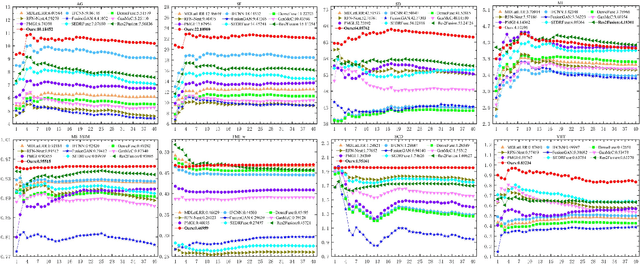
Abstract:The existing deep learning fusion methods mainly concentrate on the convolutional neural networks, and few attempts are made with transformer. Meanwhile, the convolutional operation is a content-independent interaction between the image and convolution kernel, which may lose some important contexts and further limit fusion performance. Towards this end, we present a simple and strong fusion baseline for infrared and visible images, namely\textit{ Residual Swin Transformer Fusion Network}, termed as SwinFuse. Our SwinFuse includes three parts: the global feature extraction, fusion layer and feature reconstruction. In particular, we build a fully attentional feature encoding backbone to model the long-range dependency, which is a pure transformer network and has a stronger representation ability compared with the convolutional neural networks. Moreover, we design a novel feature fusion strategy based on $L_{1}$-norm for sequence matrices, and measure the corresponding activity levels from row and column vector dimensions, which can well retain competitive infrared brightness and distinct visible details. Finally, we testify our SwinFuse with nine state-of-the-art traditional and deep learning methods on three different datasets through subjective observations and objective comparisons, and the experimental results manifest that the proposed SwinFuse obtains surprising fusion performance with strong generalization ability and competitive computational efficiency. The code will be available at https://github.com/Zhishe-Wang/SwinFuse.
Infrared and Visible Image Fusion via Interactive Compensatory Attention Adversarial Learning
Mar 29, 2022
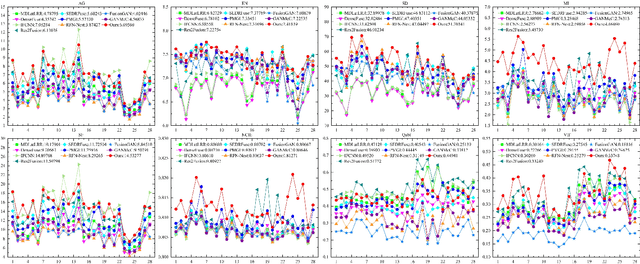

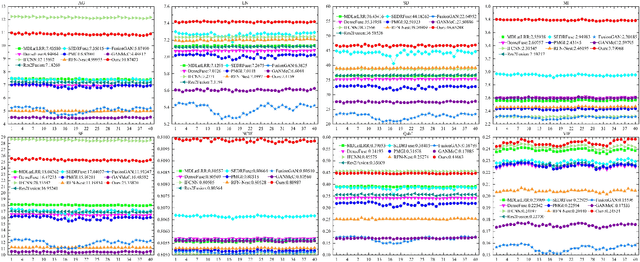
Abstract:The existing generative adversarial fusion methods generally concatenate source images and extract local features through convolution operation, without considering their global characteristics, which tends to produce an unbalanced result and is biased towards the infrared image or visible image. Toward this end, we propose a novel end-to-end mode based on generative adversarial training to achieve better fusion balance, termed as \textit{interactive compensatory attention fusion network} (ICAFusion). In particular, in the generator, we construct a multi-level encoder-decoder network with a triple path, and adopt infrared and visible paths to provide additional intensity and gradient information. Moreover, we develop interactive and compensatory attention modules to communicate their pathwise information, and model their long-range dependencies to generate attention maps, which can more focus on infrared target perception and visible detail characterization, and further increase the representation power for feature extraction and feature reconstruction. In addition, dual discriminators are designed to identify the similar distribution between fused result and source images, and the generator is optimized to produce a more balanced result. Extensive experiments illustrate that our ICAFusion obtains superior fusion performance and better generalization ability, which precedes other advanced methods in the subjective visual description and objective metric evaluation. Our codes will be public at \url{https://github.com/Zhishe-Wang/ICAFusion}
Quantum Algorithms and Lower Bounds for Linear Regression with Norm Constraints
Oct 25, 2021
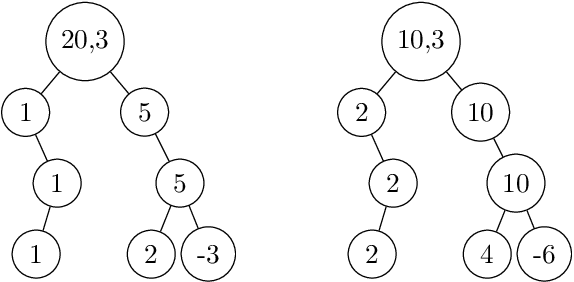

Abstract:Lasso and Ridge are important minimization problems in machine learning and statistics. They are versions of linear regression with squared loss where the vector $\theta\in\mathbb{R}^d$ of coefficients is constrained in either $\ell_1$-norm (for Lasso) or in $\ell_2$-norm (for Ridge). We study the complexity of quantum algorithms for finding $\varepsilon$-minimizers for these minimization problems. We show that for Lasso we can get a quadratic quantum speedup in terms of $d$ by speeding up the cost-per-iteration of the Frank-Wolfe algorithm, while for Ridge the best quantum algorithms are linear in $d$, as are the best classical algorithms.
Semi-supervised Optimal Transport with Self-paced Ensemble for Cross-hospital Sepsis Early Detection
Jun 18, 2021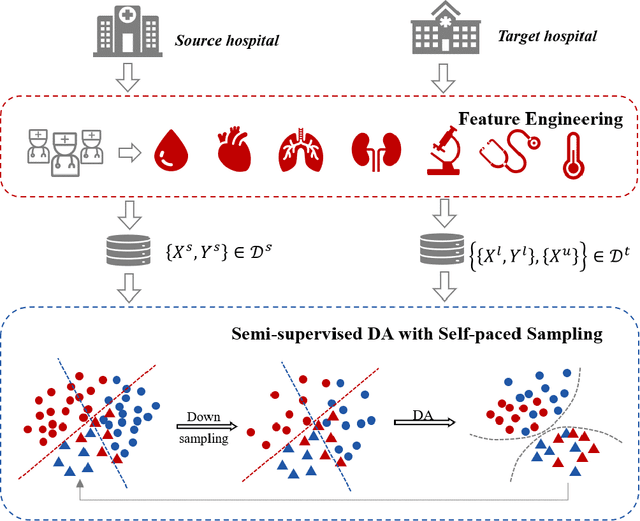
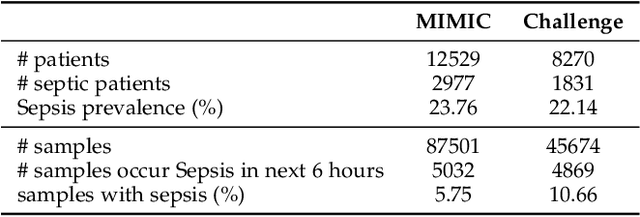

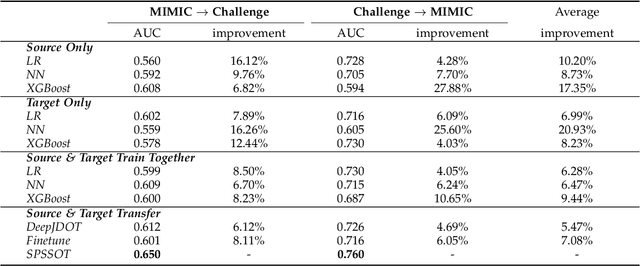
Abstract:The utilization of computer technology to solve problems in medical scenarios has attracted considerable attention in recent years, which still has great potential and space for exploration. Among them, machine learning has been widely used in the prediction, diagnosis and even treatment of Sepsis. However, state-of-the-art methods require large amounts of labeled medical data for supervised learning. In real-world applications, the lack of labeled data will cause enormous obstacles if one hospital wants to deploy a new Sepsis detection system. Different from the supervised learning setting, we need to use known information (e.g., from another hospital with rich labeled data) to help build a model with acceptable performance, i.e., transfer learning. In this paper, we propose a semi-supervised optimal transport with self-paced ensemble framework for Sepsis early detection, called SPSSOT, to transfer knowledge from the other that has rich labeled data. In SPSSOT, we first extract the same clinical indicators from the source domain (e.g., hospital with rich labeled data) and the target domain (e.g., hospital with little labeled data), then we combine the semi-supervised domain adaptation based on optimal transport theory with self-paced under-sampling to avoid a negative transfer possibly caused by covariate shift and class imbalance. On the whole, SPSSOT is an end-to-end transfer learning method for Sepsis early detection which can automatically select suitable samples from two domains respectively according to the number of iterations and align feature space of two domains. Extensive experiments on two open clinical datasets demonstrate that comparing with other methods, our proposed SPSSOT, can significantly improve the AUC values with only 1% labeled data in the target domain in two transfer learning scenarios, MIMIC $rightarrow$ Challenge and Challenge $rightarrow$ MIMIC.
 Add to Chrome
Add to Chrome Add to Firefox
Add to Firefox Add to Edge
Add to Edge